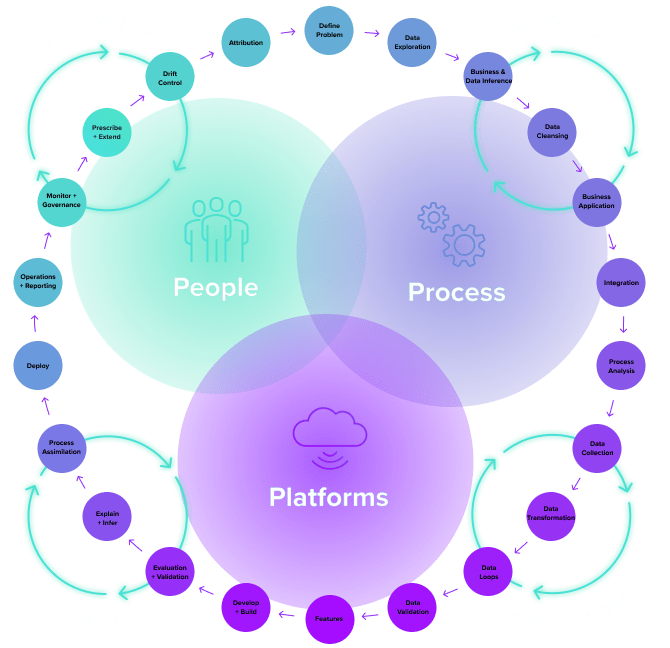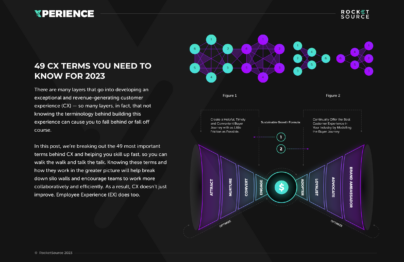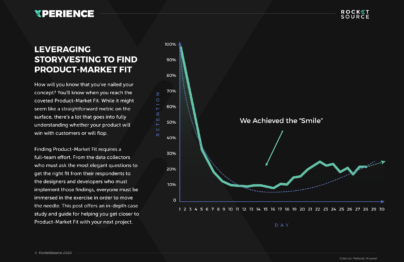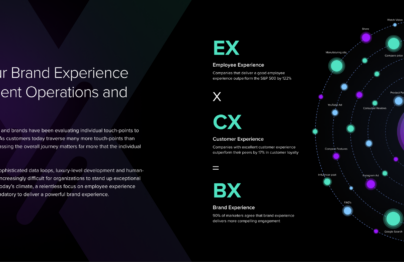Predictive analytics blend historical data with advanced technologies, such as artificial intelligence and machine learning, to make decisions about future events. These analytics use pattern recognition to help mitigate risks and bring in more money to the bottom line.
Predictive analytics is a powerful tool for any organization to have in their arsenal. As markets ebb and flow, predictive analytics give decision makers a more proactive approach to intelligent operations. These organizational leaders are able to navigate changes and react more quickly as the market demands.
As powerful as predictive analytics might be, data points alone aren’t enough to make sound business decisions. In order to receive tangible value from the data, organizations must operate from a framework rooted in human-centered design, forward-thinking empathy, and deeply rooted behavioral psychology. It’s this type of framework that allows organizations to know where to start and how to manage the available insights most effectively for a more agile, lean operation.

Successfully Deploying Predictive
Analytical Models
There must be data in place to work with in order to get to a point where an organization can be predictive. Yet too often, organizations start and end their process for gathering data at the data collection process. The platforms on which data is gathered is just the beginning. In order to adapt to today’s fast-paced market, organizations must also have the proper processes for delivering clean data to models, and then aggregating, segmenting and analyzing what’s available.
The most potent predictive analytics come as a result of skilled people who are able to take an output generated by machine learning models and apply it to something valuable within the business. Without that progression, it’s far more difficult to learn from the data and predict future market behaviors.

Leveraging Advanced Technologies to Make Predictions
The foundation for advanced technologies lies in the 3 P’s — people, processes and platforms.
Having the 3 P’s in place allows for data pipelines, data governance and digital infrastructure to work more effectively to generate predictable outcomes. Each of the 3 P’s have a direct impact on how aligned and interwoven the systems are, allowing for combinatory systems to describe, interpret, explain and control the wealth of information at an organization’s disposal.
It’s through the 3 P’s that organizations can break data out of silo walls and convey insights that are easier to understand. With this democratized data, organizations can leverage knowledge more easily and deliver higher economic value through predictive analytics.

The 4 Machine Learning Models Every Business Should Have in Place for Predictive Analytics
Lead / Opportunity / Conversions Model
It is critical for organizations to be able to predict market trends. By being able to identify and better predict the emotional and logical triggers of potential buyers, and what inspires customers to take action. As a result, organizations can put marketing spend in the areas where it’s most likely to generate a high return, and subsequently increase lead quality and conversion rates.
Attrition/Customer Retention Model
Once a customer has purchased from an organization, the company must reduce churn and increase stickiness. Predictive analytics allow businesses to identify the customers with the highest propensity to churn, understand why customers leave, and then put in the right resources to lower those attrition rates.

Lifetime Value Model
Increasing the lifetime value of a customer allows organizations to produce the most amount of value from their various cohorts of buyers. Predictive analytics allow companies to pinpoint where there are missed opportunities by better understanding where and how a customer chooses to leave or chooses to buy.

Employee Retention Model
Retaining top employees gives organizations a bigger competitive advantage. By leveraging predictive analytics internally, organizations can see when employees have a higher propensity to churn, helping put strategies in place to avoid employee turnover by rectifying concerns before it’s too late.
Customer Experience (CX) Terms
- 360° Degree View of the Customer
- AI Ops
- Barlow Bands
- Behavioral Triggers
- Bow Tie Funnel
- Brick-to-Click
- Business Impact Analysis (BIA)
- Cognitive Computing
- Cohort Analytics
- Content Mapping
- Conversational User Guidance
- Customer Data Profile
- Customer Experience (CX)
- Customer Friction
- Customer Insights Map
- Customer Journey
- Customer Journey Mapping
- Customer Satisfaction (CSAT)
- Customized Ratios
- CX Intelligence
- CX Led Growth
- CX Metrics
- Data as a Product (DaaP)
- Data as a Service (DaaS)
- Data Culture
- Data Driven
- Data Engineering
- Data Fabric
- Data Governance
- Data Humanization
- Data Hygiene
- Data Looping
- Data Mapping
- Data Mining
- Data Modeling
- Data Monetization
- Data Swamp
- Data Visualization
- Data Warehouse
- Data-Centric
- Descriptive Analytics
- Diagnostic Analytics
- Digital Asset Management (DAM)
- Digital Transformation
- Dirty Data In Dirty Data Out
- Embedded Intelligence
- Empathy Mapping
- Employee Data Profile
- Employee Experience (EX)
- EX to CX Data Mapping
- EX to CX Mapping
- Experience Management (XM)
- Gap Analysis
- Generative AI
- Human-Centered Design (HCD)
- Journey Analytics
- Machine Learning (ML)
- Managed Agile Services on Demand
- Modified Hoshin
- North Star Metric
- Party Data
- Pathway to Purchase
- Predictive Analytics
- Product-Market Fit Mapping
- Real Time Design Looping
- Revenue Acceleration
- RevOps
- S Curve of Growth
- Stack Impact Analysis
- StoryVesting
- Table Stakes Testing
- The 3 P’s
- User Experience (UX)
- User Insights Map
- User Interface (UI)
- Voice of the Customer (VoC)
- Voice of the Employee (VoE)
- World Cloud Generator Sentiment Mining
- X Analytics




